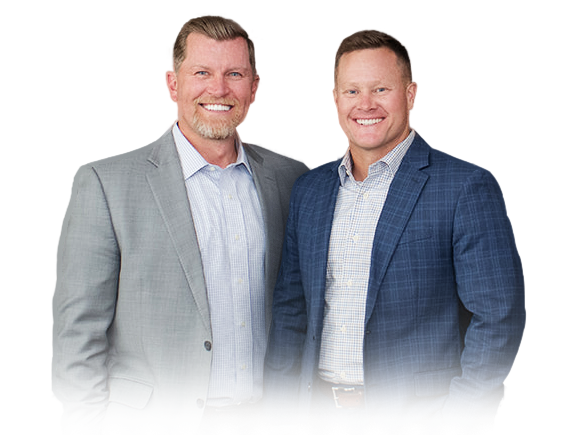 Dealing with the Allstate car accident settlement process in Utah can be tough on your own. At Good Guys Injury Law, we help accident victims get fair payment after crashes with Allstate Insurance drivers. We know how to handle big insurance companies like Allstate and State Farm to protect your rights during your car accident claim.
Dealing with the Allstate car accident settlement process in Utah can be tough on your own. At Good Guys Injury Law, we help accident victims get fair payment after crashes with Allstate Insurance drivers. We know how to handle big insurance companies like Allstate and State Farm to protect your rights during your car accident claim.
You need to know what to expect after a car accident with an Allstate-insured driver. This guide explains each step, from filing your claim to getting a fair settlement for your medical bills and lost wages. Understanding how Allstate handles claims can help you avoid mistakes that might lower your payment.
Table of Contents
Understanding the Allstate Car Accident Settlement Process
When you’re hurt in a car accident, dealing with Allstate can be confusing. As one of the largest insurance companies in America, they have set ways to handle auto accident claims in Utah. Let’s look at how they process claims and how this affects your payment for injuries and car damage.
How Allstate Handles Auto Accident Claims
Allstate deals with thousands of car accident claims every year. After you report an accident, they assign an insurance adjuster to your case. This person reviews the police report, checks the crash details, and decides who is at fault. Remember, this adjuster works for Allstate, not for you.
Unlike other insurance companies, Allstate heavily uses computer systems and standard processes. They often ask for recorded statements that could hurt your case later. While they claim you’re “in good hands,” their main goal is saving money, not making sure you get fully paid for your medical bills, property damage, and pain after an automobile accident.
Allstate’s Claims Evaluation System
Allstate employs sophisticated computer programs to evaluate how much to offer for Allstate accident claims. The system analyzes data about your injuries and treatment, then calculates a payment based on similar cases from the past. The insurance adjuster inputs codes for each part of your claim, and the system provides a dollar amount for your initial settlement offer.
It’s crucial to seek medical attention promptly after an accident to ensure your injuries are properly documented. This medical attention not only aids your recovery but also strengthens your claim by providing concrete evidence of your injuries, which the system uses to determine compensation.
The problem with this approach is that it often misses the unique parts of your situation. A traumatic brain injury might look the same as another case on paper, but it affects your life in completely different ways. The system might not properly value your medical condition, ongoing medical expenses, or chronic pain. Because of these limits, Allstate’s initial settlement offer is often much lower than the fair value of your claim. That’s why having a personal injury lawyer review any offer before you accept is so important.
Filing a Car Accident Claim with Allstate Insurance
 After a crash with an Allstate-insured driver, knowing the right steps to file your claim makes a big difference. The filing process sets up your entire claim, and early mistakes can be hard to fix later. Here’s how to handle this crucial first step.
After a crash with an Allstate-insured driver, knowing the right steps to file your claim makes a big difference. The filing process sets up your entire claim, and early mistakes can be hard to fix later. Here’s how to handle this crucial first step.
Steps to Report an Accident & Start a Claim
Prioritize getting medical help immediately, regardless of how slight your injuries may appear. Many serious conditions don’t show symptoms right away. Once you’ve seen a doctor, report the accident to Allstate within 24 hours. You can call their claims hotline or visit Allstate’s website. Have your policy number and basic accident details ready.
Next, gather evidence for your claim:
- Document the collision by photographing the car’s damage, the scene of the incident, and any visible wounds
- Get contact info from witnesses and the other driver
- Collect insurance information
- Get a copy of the police report
- Keep all medical bills, repair estimates, and proof of lost wages
These documents help establish the value of your claim during settlement talks with Allstate claims adjusters.
Common Mistakes to Avoid When Filing
One big mistake is giving recorded statements without talking to a lawyer first. Insurance adjusters ask questions that might trick you into admitting fault or making your injuries sound less serious. These statements can lower your settlement or even give Allstate a reason to deny your claim.
Another error is taking the first settlement offer before you know how bad your injuries really are. Some health conditions get worse over time, and settling too quickly might leave you with ongoing medical expenses not covered by your payment. Also, don’t post about your accident on social media – Allstate adjusters often check these sites for info they can use against you.
The Claims Process: What to Expect with Allstate
Once you’ve filed your accident claim, Allstate will investigate your case and decide how much they’ll pay. Understanding this process helps you know how decisions about your claim are made and how long you might wait for payment.
How Allstate Investigates Auto Accident Claims
After you file a claim, Allstate starts checking the details of your accident. They look at the police report, study photos of the damage, and might send someone to inspect your car. In serious crashes, they might recreate the accident scene to figure out exactly how the collision happened and who crossed the center line. They’ll also check if the at-fault driver’s auto insurance policy was active when the crash occurred.
This investigation usually takes 2-4 weeks, though complex cases take longer. During this time, keep detailed records of all medical treatments and document how your injuries affect your daily life. Be careful about signing medical release forms that give Allstate access to your entire health history.
The Role of the Claims Adjuster
The claims adjuster manages your case from start to finish. They gather evidence, talk to witnesses, review medical records, and decide what your claim is worth. These professionals are trained to find ways to pay less by looking for pre-existing conditions or other factors that might reduce what Allstate owes you.
When talking with an adjuster, be polite but careful. Stick to facts, and don’t guess about the accident or your injuries. Write down all communications, including dates, times, and what was discussed. If you work with us, we can handle these talks for you, making sure you don’t say anything that might hurt your claim.
Dealing with Allstate After a Car Accident
 The first few weeks after your car accident are crucial for your claim. How you talk with Allstate representatives can either help or hurt your chances of getting fair payment for your injuries and damages.
The first few weeks after your car accident are crucial for your claim. How you talk with Allstate representatives can either help or hurt your chances of getting fair payment for your injuries and damages.
When Allstate first calls you, they often seem helpful and concerned. But remember, these early talks are part of their assessment. While the person may be friendly, their main job is gathering information that helps Allstate. Keep what you share simple, sticking to basic facts about when and where the accident happened. Don’t talk about who was at fault or guess about your injuries.
During the review process, Allstate will ask for proof of your damages and injuries. They may want access to your medical records, proof of lost wages, and repair estimates for your car. Only provide what relates directly to your current claim. For medical information, have your lawyer check any release forms before signing.
Evaluating Auto Accident Claims with Allstate
Understanding how Allstate decides what your claim is worth helps you know if their offer is fair. Allstate uses specific formulas and looks at various factors when calculating settlements. Knowing this process helps you build a stronger case for the money you deserve after an auto accident.
How Allstate Calculates Settlement Offers
Allstate uses both software and adjuster judgment to add a dollar amount to your claim. They start by adding up your economic damages – these are specific costs like:
- Medical expenses and past medical expenses
- Property damage to your vehicle
- Lost wages from missed work
These numbers are fairly straightforward, though Allstate might question whether some medical treatments were needed.
The harder part is valuing non-economic damages like pain and suffering. For these, Allstate often uses a multiplier method. They take your medical expenses and multiply them by a number between 1 and 5 based on how severe your injuries are. For minor injuries, they might use 1 or 1.5, while severe injuries like traumatic brain injury might get a higher number. This approach often undervalues your suffering, especially for injury claims involving long-term chronic pain.
Factors That Influence Claim Value
Several key factors can raise or lower your settlement value:
- The severity of your injuries – long-lasting or permanent injuries typically result in higher settlements
- Clarity of liability – if the other driver was clearly at fault, your position is stronger
- Medical treatment choices – following doctor’s orders and getting treatment quickly strengthen your case
- Whether you have health insurance, this can affect how medical bills are handled
Under Utah’s modified comparative negligence system, your financial recovery could be reduced in proportion to how much you were at fault for the incident. If you’ve found 30% responsible for the crash, your payment will be reduced by 30%. If you’re more than 50% at fault, you can’t recover damages from the other party. This makes it crucial to gather evidence showing the negligent driver’s fault.
Negotiating with Allstate for a Fair Settlement
 Getting a fair settlement from Allstate takes smart negotiation and patience. Their initial offer is rarely their best offer, and knowing how to respond can greatly increase your final payment. This is where having an experienced personal injury lawyer often makes the biggest difference.
Getting a fair settlement from Allstate takes smart negotiation and patience. Their initial offer is rarely their best offer, and knowing how to respond can greatly increase your final payment. This is where having an experienced personal injury lawyer often makes the biggest difference.
A good strategy when negotiating with Allstate adjusters is to present a complete package that clearly shows all your damages. Include full medical records, bills, proof of lost income, and evidence of how your injuries have changed your daily life. Support your settlement demand with specific examples and expert opinions from your medical providers.
When Allstate makes its initial settlement offer, it will likely be much lower than your claim’s real value. Don’t be upset by this tactic – it’s how they start settlement negotiations. Respond with a detailed letter explaining why their offer isn’t enough, addressing any misunderstandings or missing information. Be specific about which parts of your damages they’ve undervalued.
Successful settlement negotiations with Allstate require patience. Insurance adjusters can increase offers, but they won’t unless they think you might take your case further. Be ready for several rounds of offers and counteroffers. Throughout this process, document all communications. If you’re working with our firm, we handle these negotiations for you, using our experience to push for a higher settlement while you focus on recovery.
Common Challenges in Allstate Auto Accident Cases
Dealing with Allstate after a car accident often involves several roadblocks that can delay fair payment. Being ready for these challenges helps you handle them better and improves your chances of a good outcome for your accident claim.
A common problem is Allstate’s tendency to dispute liability, even when fault seems obvious. They might argue that you share some blame for the incident or suggest your injuries were pre-existing rather than caused by the collision. These tactics aim to reduce their payout under Utah’s comparative negligence laws, where your compensation decreases based on your degree of fault.
Delay tactics are another frequent issue when dealing with Allstate. The company might take too long to respond to messages, ask for unnecessary documentation, or repeatedly assign new adjusters to your case. Each of these actions stretches out the timeline, putting pressure on you to take a lower offer out of financial need.
Disputed medical claims present another major challenge in auto accident cases. Allstate might question whether your injuries came from the accident or argue that your treatment was excessive. They often use in-house lawyers who rarely see you in person, yet declare your treatment unnecessary. To overcome this, get detailed documentation from your medical providers linking your injuries directly to the accident.
When to Consider Legal Action Against Allstate
There are clear signs that working with Allstate has reached a point where you need a lawyer. Spotting these warning signals early can save you time, stress, and potentially thousands in compensation.
If Allstate denied your claim despite clear evidence of the other driver’s fault, it’s time to talk to a lawyer. Similarly, if they make an offer that doesn’t even cover your basic medical bills and property damage, they’re not treating your claim fairly. Watch for situations where Allstate refuses to respond to your messages or repeatedly asks for the same information.
Under Utah law, you must initiate a personal injury lawsuit within four years of the accident if you plan to seek compensation from the at-fault party or their insurance provider.. This might seem like plenty of time, but building a strong case takes time. As time goes by, evidence may be lost, witnesses forget, and medical documents become less available.
At Good Guys Injury Law, we specialize in handling difficult insurance companies like Allstate. When settlement negotiations stall, we can take stronger steps, including filing a lawsuit if needed. Our injury lawyers have extensive experience with Allstate’s tactics and know how to counter them effectively.
Types of Coverage in Allstate Auto Insurance Policies
 Allstate provides various auto insurance coverages, so understanding them helps you see what compensation you could receive after an accident. The specific policy held by you or the at-fault driver directly impacts your claim options and potential settlement amount.
Allstate provides various auto insurance coverages, so understanding them helps you see what compensation you could receive after an accident. The specific policy held by you or the at-fault driver directly impacts your claim options and potential settlement amount.
Liability vs. Full Coverage
In Utah, liability insurance is the legal minimum. It pays for others’ medical bills and property damage if you’re at fault in a crash. Coverage includes bodily injury ($ 25,000 per person and $65,000 per accident) and property damage ($15,000). Both are required by law.
Full coverage offers much broader protection by adding comprehensive and collision coverage to basic liability insurance. Collision coverage repairs your car after any accident, no matter who’s at fault, while comprehensive coverage covers non-crash incidents like theft.
How PIP & Uninsured Motorist Coverage Apply
Personal Injury Protection (PIP) is required in Utah as part of its no-fault insurance system. PIP covers your medical expenses and lost wages up to your policy limits (minimum $3,000), regardless of who caused the accident. You must use this coverage first before pursuing a claim against the at-fault driver, and you can only step outside the no-fault system if your medical expenses exceed $3,000 or you’ve suffered serious injuries.
Uninsured/underinsured motorist (UIM) coverage becomes vital when the at-fault driver either has no insurance or lacks enough coverage to pay for all your damages. If you’ve sought UIM benefits from Allstate because the other driver had inadequate coverage, Allstate should treat you like its own policyholder. Yet, many claimants with a shoulder injury or other serious injury find that Allstate still fights these claims aggressively.
How Long Does an Allstate Settlement Take?
Most straightforward Allstate claims in Utah take between 30 and 90 days to settle. This timeline starts once you’ve completed medical treatment. Minor accidents with clear liability tend to resolve faster, often within a month after treatment ends. More complex cases involving severe pain or disputed liability can take six months to a year, especially if a lawsuit becomes necessary. Many cases in Baltimore County follow similar timelines. Allstate generally won’t offer its best settlement until they have complete information about your injuries.
Several factors can extend or shorten your settlement timeline:
- The severity of your injuries – cases involving ongoing treatment require more documentation
- Clarity of liability – accidents where fault is disputed take longer to resolve
- Your actions – promptly providing requested documentation speeds up the process
Contact Good Guys Injury Law for a Free Consultation
 At Good Guys Injury Law, we specialize in handling Allstate car accident claims in Utah. Our experience fighting against their tactics helps us value your claim accurately and counter lowball offers. We gather evidence, document damages, and handle all communications with adjusters to protect your interests. Our injury lawyers recognize delay tactics and unfair denials and can address the specific circumstances of your case, including understanding how the party involved affects your claim.
At Good Guys Injury Law, we specialize in handling Allstate car accident claims in Utah. Our experience fighting against their tactics helps us value your claim accurately and counter lowball offers. We gather evidence, document damages, and handle all communications with adjusters to protect your interests. Our injury lawyers recognize delay tactics and unfair denials and can address the specific circumstances of your case, including understanding how the party involved affects your claim.
Don’t face Allstate alone after a car crash. Contact us today for a free consultation to review your case. We’ll assess your claim’s value while you focus on recovery. You pay nothing unless we win your case, and insurance companies typically offer higher settlements when you have legal representation.






